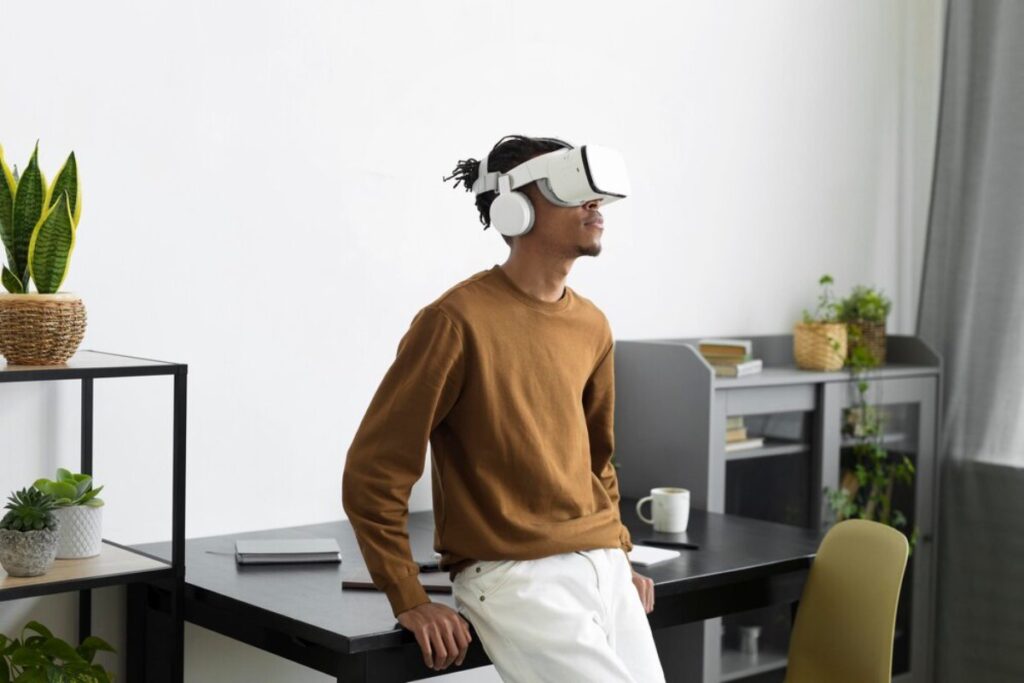The Technology Blog

AI in Wearable Technology: Enhancing Daily Experiences
What if your watch could detect stress before you feel it? Or if your ring could recommend when to sleep, work out, or rest based on your body’s real-time signals? These aren’t just futuristic dreams anymore—they’re the new normal, thanks to AI wearables.
Wearable technology has progressed beyond tracking steps or calories. Smart devices today are clever companions. They provide feedback, make predictions, and offer support. They learn from user data all the time. With artificial intelligence (AI), wearables have changed. They now serve as powerful tools for personalised health, safety, and lifestyle improvement.
In this blog, we’ll look at how AI is changing wearable tech. We’ll cover the industries it impacts, its benefits and drawbacks, and what’s coming next for personal tech that aims to enhance daily life.
What Are AI Wearables?
AI wearables are devices you wear that use artificial intelligence. They collect, analyse, and respond to data instantly. They’re smart because they don’t just record information—they learn from it.
Key Features:
- Sensor integration: Heart rate, temperature, movement, skin conductivity, oxygen levels
- Adaptive algorithms: AI personalises insights based on your habits and physiology
- Real-time alerts: Notifications and nudges designed to guide your behaviour or warn of potential issues
- Machine learning models: Continuously improve recommendations over time
AI is found in many devices, including smartwatches, fitness trackers, rings, glasses, earbuds, and even smart clothing.

How AI Enhances Wearable Technology
1. Smart Health Monitoring
AI wearables track data to check your health. They can spot problems early, often before they get serious.
Capabilities include:
- Monitoring heart rate variability (HRV), blood oxygen (SpO2), body temperature, and respiratory rate
- Detecting abnormal rhythms (like AFib)
- Providing early warnings for potential illness
- Guiding recovery after workouts or illness
Example: The Oura Ring accurately predicted illness onset, including COVID-19, through slight physiological changes days before symptoms appeared.
2. Fitness and Activity Coaching
AI-powered wearables personalise fitness routines based on your history and physical condition.
Features:
- Custom workout plans that evolve as you progress
- Real-time coaching based on form, intensity, or heart rate zones
- Recommendations on rest days or recovery routines
Popular devices: Garmin smartwatches, WHOOP bands, and Fitbit devices use AI to suggest rest days, daily readiness scores, or adaptive goals.
3. Sleep Analysis and Optimisation
Sleep is key to our health. AI wearables have changed how we track and enhance it.
Benefits:
- Tracks sleep stages (light, deep, REM)
- Analyses environmental factors like noise or temperature
- Offers tips for improving sleep quality
- Integrates with other apps for bedtime routines or smart alarms
Standout device: The Oura Ring is widely praised for its in-depth sleep tracking and accuracy, influencing wellness decisions like bedtime or caffeine intake.
4. Mental Health and Stress Management
With rising awareness of mental health, AI is enabling wearables to track stress and recommend relief strategies.
Key features:
- Measures stress via HRV, electrodermal activity (EDA), or breathing patterns
- Provides guided meditation, breathwork, or mindfulness sessions
- Alerts you when stress is rising—even if you haven’t noticed it yet
Example: Fitbit Sense includes a stress management score and recommends breathing exercises when tension builds.

5. Safety and Emergency Features
AI wearables aren’t just for wellness—they can also act as safety tools.
Use Cases:
- Fall detection (common in smartwatches for seniors)
- SOS alerts via button, gesture, or voice
- Geolocation tracking for kids or at-risk individuals
- Noise level monitoring to prevent hearing damage
Apple Watch and Samsung Galaxy Watch are leading the pack with fall detection and emergency call capabilities—life-saving in many real-world incidents.
Wearables in Different Sectors
A. Healthcare
Wearables are revolutionising remote patient monitoring.
- Continuous data helps clinicians detect early signs of heart issues, diabetes, or seizures
- Reduces hospital visits and improves patient independence
- Integrates with electronic health records (EHRs) for seamless care
B. Sports and Athletics
Athletes and coaches use AI wearables for performance analytics.
- Real-time movement tracking
- AI-based injury prevention models
- Training personalisation based on recovery cycles
Example: WHOOP is popular among elite athletes for recovery insights and strain scoring.
C. Workplace Productivity
Wearables enhance focus and manage fatigue in high-performance workplaces.
- Smart rings that monitor energy and productivity cycles
- Glasses that reduce eye strain with adaptive brightness
- AI recommending micro-breaks or meditation for mental clarity
D. Everyday Convenience
From controlling smart homes to contactless payments, wearables simplify everyday tasks.
- Contactless payments via smartwatches or rings
- Smart assistants (e.g. Alexa, Siri) on your wrist or glasses
- Environmental tracking (UV levels, pollution, hydration)
AI Wearables vs. Traditional Wearables
| Feature | AI Wearables | Traditional Wearables |
|---|---|---|
| Learning Ability | Learns and adapts | Static features |
| Personalisation | Highly tailored | One-size-fits-all |
| Proactivity | Anticipates and alerts | Waits for user input |
| Insights | Predictive and holistic | Basic tracking only |
| Integration | Syncs with health & smart home systems | Limited compatibility |
Conclusion: AI wearables move from passive tools to active lifestyle partners.
Challenges and Concerns
1. Privacy and Data Security
These devices collect sensitive personal data. Without strict safeguards, misuse or breaches are possible.
- Always check privacy policies
- Look for end-to-end encryption
- Opt for companies that are transparent about third-party sharing

2. Affordability and Accessibility
High-end AI wearables can be expensive, limiting access to only certain user groups.
- Some brands now offer stripped-down versions with essential features
- Public health programmes are exploring wearables for population health monitoring
3. Data Accuracy
AI wearables are powerful, but not always perfect.
- Accuracy can vary across skin tones, body types, or conditions
- Some algorithms may still show bias or be poorly trained
Tip: Don’t use wearable data for diagnosis—always consult a healthcare professional.
4. Device Overload and “Alert Fatigue”
Too many alerts can be overwhelming and cause anxiety.
- Choose devices that allow customisation
- Balance “always on” tracking with intentional disconnection
What’s Next for AI Wearables?
The future of AI wearables is full of exciting possibilities:
Upcoming Trends:
- Emotion-aware AI: Devices that recognise and respond to your emotional state
- Energy harvesting: Wearables powered by body heat or movement
- Multi-modal AI: Combining sound, visuals, motion, and biometric data for deeper insights
- Biometric authentication: Secure access to banking, smart homes, or work systems via your wearable
Wearables will also play a growing role in preventive health, chronic care management, and AI-assisted elder care.
How to Choose the Right AI Wearable
When picking an AI wearable, consider:
- Your goal: Health? Productivity? Sleep? Safety?
- Device compatibility: Does it sync with your phone or health apps?
- Battery life: Daily charging or once-a-week convenience?
- AI features: Does it learn from your behaviour and adjust?
- Comfort and style: If it’s not comfortable, you won’t wear it!
Everyday Intelligence on Your Wrist (or Finger, or Glasses)
Wearable technology powered by AI is no longer a novelty—it’s becoming a standard. These smart companions help us understand our bodies. They manage our energy, boost our well-being, and make daily life easier.
From healthcare to productivity enhancement, AI wearables are changing how we engage with the world—and with ourselves.
Take action today: Whether you’re an early tech adopter or exploring your first device, find the AI wearable that fits your life and goals. Smarter living is just a wrist tap away.









